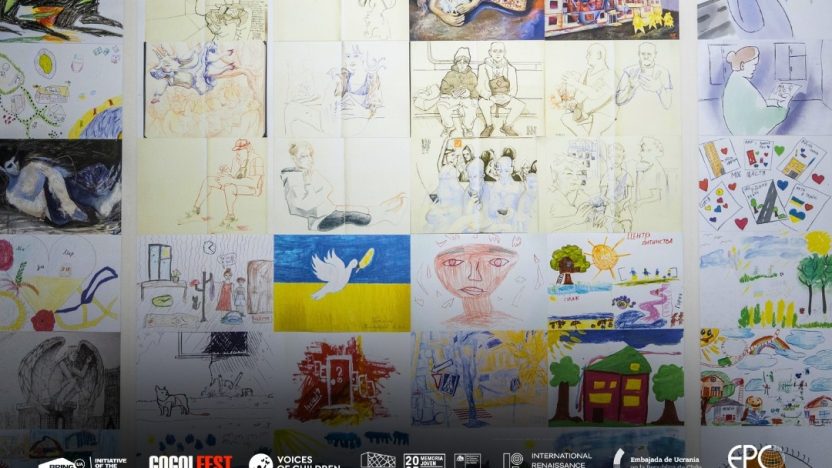On 17 October, an exhibition opened in Santiago, the capital of Chile, combining two tragedies — one from the past and one from the present. The Museum of Memory and Human Rights (Museo de la Memoria y los Derechos Humanos), created in memory of the victims of the Chilean dictatorship, opened a multimedia exhibition entitled No hay niños, hay gente (‘There are no children, there are people’).
It tells the story of one of the greatest war crimes of our time — the illegal deportation and forced displacement of thousands of Ukrainian children by the Russian Federation. The exhibition will run until 30 November 2025. Admission is free. Details are available on the museum’s website.
The venue for the exhibition is no coincidence. The Museum of Memory and Human Rights preserves the history of how dictatorship destroys people’s lives. Now, the voices of Ukrainian children — those whom Russia kidnaps, deports and tries to deprive of their identity — can be heard in its space.
What is the exhibition No hay niños, hay gente about
The exhibition highlights the issue of deportation through art. The exhibition combines several formats — children’s drawings and documentary evidence. Visitors can see:
- installations of works by Ukrainian children on the theme of war;
- animated films Mariupol. One Hundred Nights by director Sofia Melnyk and There Are No Children, There Are People by director Tetiana Troitska with music by the band DakhaBrakha;
- documentary video stories prepared by the Voices of Children Foundation and the Ukrainian president’s initiative Bring Kids Back UA;
- the short film Generation, shot by teenagers with experience of war.




The opening of the exhibition featured speeches by Yuriy Dyudin, Ukraine’s ambassador to Chile, director Vladislav Troitsky, psychologist Oksana Pysareva from the Voices of Children Foundation, and museum director Maria Fernanda Garcia Irribaren.
This project is an attempt to look into the heart of war through the eyes of children. The exhibition raises awareness of how war changes the very concept of childhood and asks viewers: what are we, as a society, prepared to do to ensure that these children do not remain mere statistics?
— emphasised exhibition curator Vladislav Troitsky, director and founder of GogolFest..


Children also shared their stories — Anna from Kharkiv and Marta from occupied Donetsk. Marta grew up in occupied Donetsk, studied remotely at a Ukrainian school, and waited until she came of age to move to Kyiv. She is currently studying at Kyiv National Linguistic University and dreams of becoming a linguist. Anna, a 16-year-old girl from Kharkiv, became the heroine of one of the video stories about childhood during wartime.


We have gathered in a place that embodies memory, truth and justice to talk about one of the most horrific crimes of our time — the abduction and illegal deportation of Ukrainian children by Russia. They are not “collateral damage” — they are people with their own dignity and dreams. Every drawing, every voice represented in this exhibition is a testimony to pain, strength, hope and resilience. Bringing every child home is a moral mission for the whole world,
said Ukrainian Ambassador Yuriy Dyudin, emphasising the symbolic significance of the exhibition venue.


The opening ceremony concluded with a musical performance by DakhTrio, which combined Ukrainian motifs with poems by a Chilean poet.
Bringing children home is only the beginning
Oksana Pysareva, a psychologist at the Voices of Children Foundation, noted that bringing children home is not the end of the story, but rather the beginning.
Bringing children back to Ukraine is a difficult task. But it is even more difficult to give them another chance to live their lives. This project is a gentle look at their trauma, acceptance of their experiences and respect for what they have been through, Oksana commented.

Museum director María Fernanda García Irribarren noted that remembering the tragedies of the past only makes sense if it helps prevent crimes in the present.
Today, we speak in unison with Ukrainian children, their families, and the entire nation fighting for the right to live in peace. Art has the power to restore humanity even after the most difficult experiences, and it is through such initiatives that a culture of remembrance based on empathy, dignity, and truth is formed, she added.

Why it is important to talk about deportation
What is happening to Ukrainian children in the occupied territories and in Russia is a systematic criminal policy of the Kremlin aimed at eradicating Ukrainian identity. These actions violate the Geneva Conventions and the UN Convention on the Rights of the Child. The International Criminal Court has recognised the deportation of Ukrainian children as a war crime.
More than 1.6 million Ukrainian children are in Russian-occupied territories. Tens of thousands have been illegally deported to Russia. Some children are forcibly sent to so-called ‘re-education camps,’ where they are forced to renounce the Ukrainian language, change their citizenship, and prepare to participate in future Russian wars.

The exhibition in Santiago aims to show the world the scale of the tragedy and unite societies around a common demand — to bring the children home. The project was implemented with the support of the International Renaissance Foundation. The exhibition’s partners are the Museum of Memory and Human Rights in Santiago, the Ukrainian Embassy in Chile, the GogolFest team, the Voices of Children Foundation, and the Ukrainian President’s Bring Kids Back UA initiative.
The foundation’s specialists work with children and families affected by the war, including supporting children who have been returned from deportation and occupation. Our experience shows that recovery from such traumatic events takes time, professional support and understanding.
Help us spread the truth about what is happening to Ukrainian children. The world needs to hear their voices — the ones that Russia is trying to silence.
Source: Voices of Children

